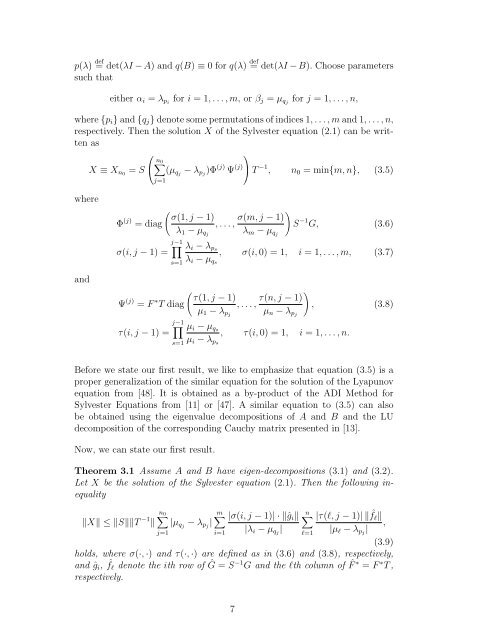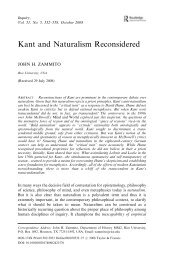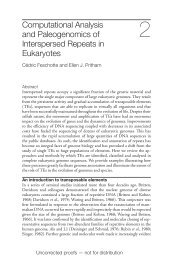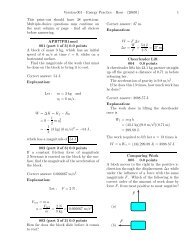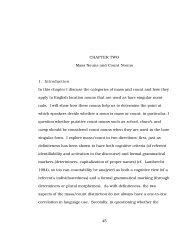Low Rank ADI Solution of Sylvester Equation via Exact Shifts
Low Rank ADI Solution of Sylvester Equation via Exact Shifts
Low Rank ADI Solution of Sylvester Equation via Exact Shifts
You also want an ePaper? Increase the reach of your titles
YUMPU automatically turns print PDFs into web optimized ePapers that Google loves.
p(λ) def = det(λI − A) and q(B) ≡ 0 for q(λ) def = det(λI − B). Choose parameterssuch thateither α i = λ pi for i = 1, . . . , m, or β j = µ qj for j = 1, . . . , n,where {p i } and {q j } denote some permutations <strong>of</strong> indices 1, . . . , m and 1, . . . , n,respectively. Then the solution X <strong>of</strong> the <strong>Sylvester</strong> equation (2.1) can be writtenas⎛⎞∑n 0X ≡ X n0 = S ⎝ (µ qj − λ pj )Φ (j) Ψ (j) ⎠ T −1 , n 0 = min{m, n}, (3.5)j=1whereandΦ (j) = diagσ(i, j − 1) =( )σ(1, j − 1) σ(m, j − 1), . . . , S −1 G, (3.6)λ 1 − µ qj λ m − µ qjj−1 ∏s=1Ψ (j) = F ∗ T diagτ(i, j − 1) =j−1 ∏s=1λ i − λ psλ i − µ qs, σ(i, 0) = 1, i = 1, . . . , m, (3.7)( )τ(1, j − 1) τ(n, j − 1), . . . , , (3.8)µ 1 − λ pj µ n − λ pjµ i − µ qsµ i − λ ps, τ(i, 0) = 1, i = 1, . . . , n.Before we state our first result, we like to emphasize that equation (3.5) is aproper generalization <strong>of</strong> the similar equation for the solution <strong>of</strong> the Lyapunovequation from [48]. It is obtained as a by-product <strong>of</strong> the <strong>ADI</strong> Method for<strong>Sylvester</strong> <strong>Equation</strong>s from [11] or [47]. A similar equation to (3.5) can alsobe obtained using the eigenvalue decompositions <strong>of</strong> A and B and the LUdecomposition <strong>of</strong> the corresponding Cauchy matrix presented in [13].Now, we can state our first result.Theorem 3.1 Assume A and B have eigen-decompositions (3.1) and (3.2).Let X be the solution <strong>of</strong> the <strong>Sylvester</strong> equation (2.1). Then the following inequality‖X‖ ≤ ‖S‖‖T −1 ∑n 0m∑ |σ(i, j − 1)| · ‖ĝ i ‖n∑ |τ(l, j − 1)| ‖‖ |µ qj − λ pj |ˆf l ‖,j=1i=1|λ i − µ qj |l=1|µ l − λ pj |(3.9)holds, where σ(·, ·) and τ(·, ·) are defined as in (3.6) and (3.8), respectively,and ĝ i , ˆf l denote the ith row <strong>of</strong> Ĝ = S−1 G and the lth column <strong>of</strong> ˆF ∗ = F ∗ T ,respectively.7


